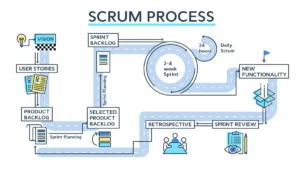Git is a distributed version control system. Every dev has a working copy of the code and full change history on their local machine, and can easily share and undo changes to subscribers all over the world. It is a critical part of the development cycle, and all developers will need to use it in some form. Starting out, git can be daunting as it requires terminal and typed commands. A high bar for new developers.
This article will introduce a few of the Git commands I found the most useful.
How to get started (Basic workflow)
Cloning a project
Copy the URL, then navigate to the location you would like your repository stored in.
Enter the command below with <repo_url> replaced with the URL just copied.
git clone <repo_url>
Making changes
Create a new branch to work on.
git checkout -b <new_branch_name>
Make required changes and stage all changes.
git add .
Commit these changes.
git commit
Push changes to the main branch.
git push -u origin <new_branch-name> // only needed for first commit
Note: For all subsequent commits, running git push is sufficient.
How to pull changes from the <main_branch> to your branch
If you require the newest changes on the main branch integrated on your local branch, use git merge or rebase to update the branch. For more information on the difference between merging and rebasing, check out this article.
Using rebase
git stash -u //stash all your working files git checkout <main_branch> git pull git checkout <your_branch> git rebase <main_branch> git stash pop //re-apply all your changes
Using merge
git stash -u //stash all your working files git checkout <main_branch> git pull git checkout <your_branch> git merge <main_branch> git stash pop //re-apply all your changes
Dealing with merge conflicts
If you see merge conflicts, do not worry. All you need to do is go through each of the conflicted files and resolve each conflict. Simply select whether you want to keep the incoming or current changes. Also, be sure to delete all the dividers.
<<<<<<< HEAD ======= >>>>>>> branch
After all the conflicts are resolved, stage all changes and push the commit.
Edit your commit message
The command below will open back up the text editor and from there you can modify the commit message.
git commit — amend
Rename your branch
What if you named your branch wrong or wanted to change it to something more fitting? The command below allows you to rename your branch.
git branch -m <new_name>
Find your branch name
Sometimes you may be working with multiple branches, and it is hard to remember the exact name of each one. Running the command below will list out all the branches in your repository. To exit out of the list and return, simply type ‘q’.
git branch
Revert your last commit
You might find yourself in the situation where you have pushed a commit but realized you left some changes out. What do you do? Well fortunately, you can simply undo your last commit.
git reset head~1
This command reverts your last commit, and you will see all the changes back in the staging area. You can commit these changes again later.
See project commit history
The command below shows you the commit history.
git log
See branch history
This command displays the changes in the working directory. It shows you what changes are staged, unstaged, or untracked.
git status
Discover more from AJB Blog
Subscribe to get the latest posts sent to your email.







